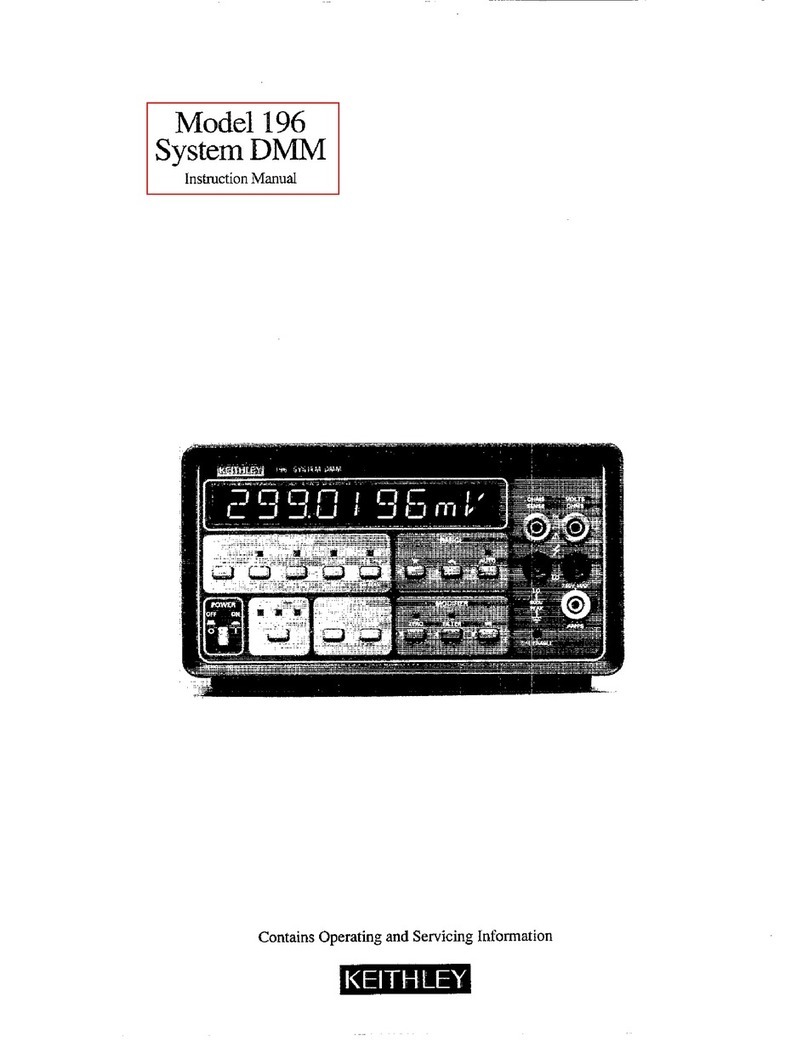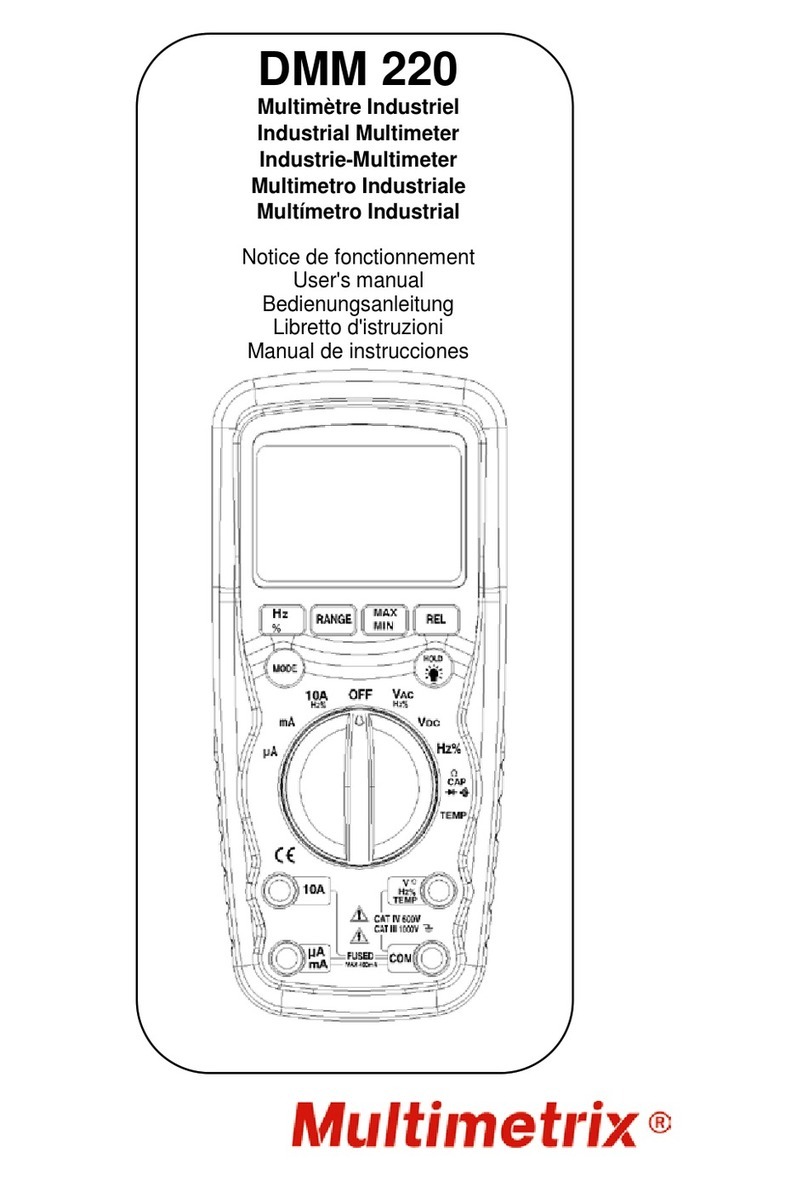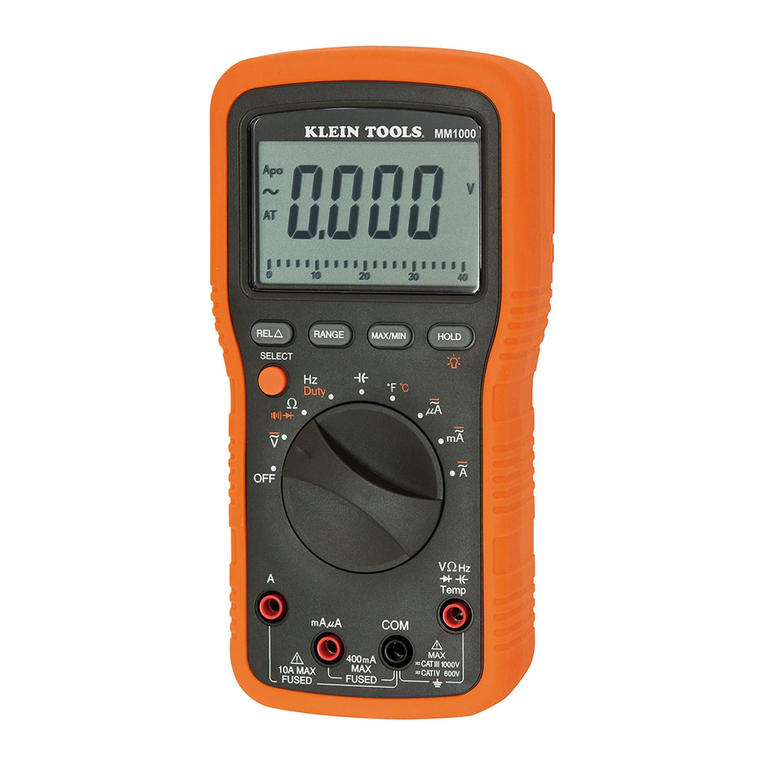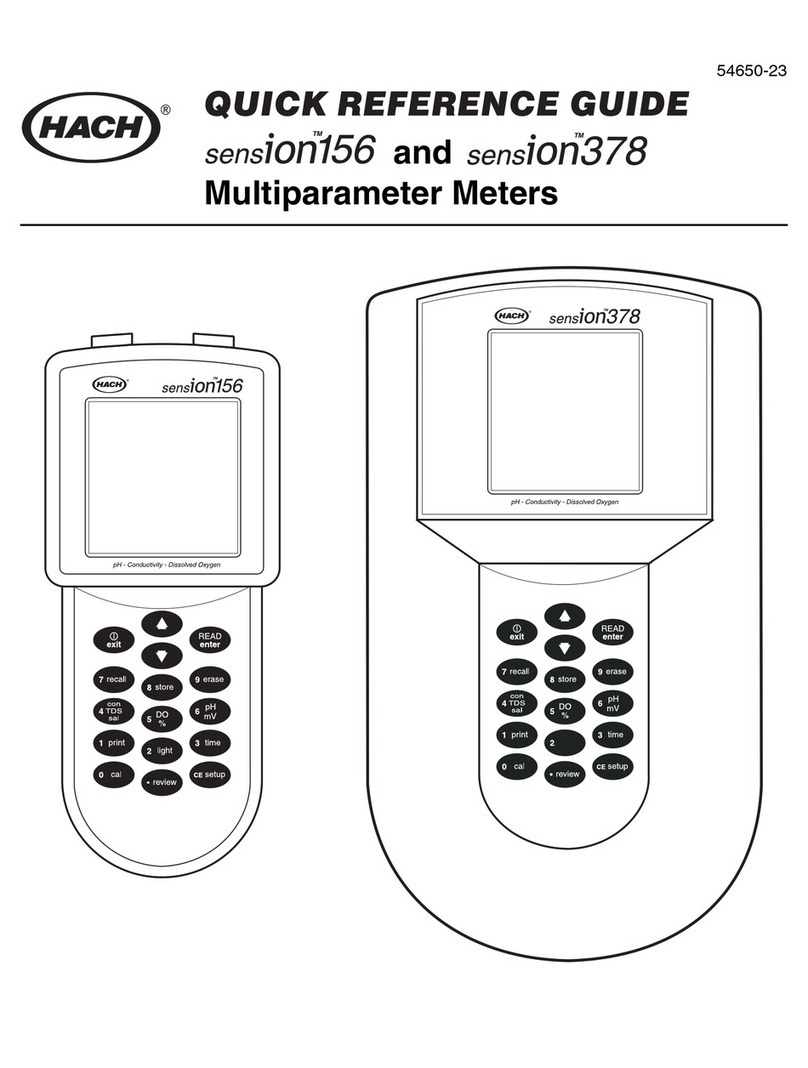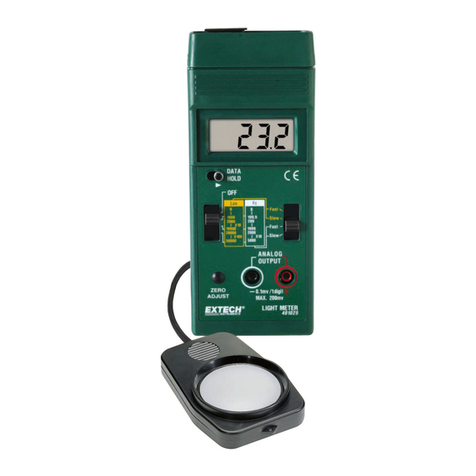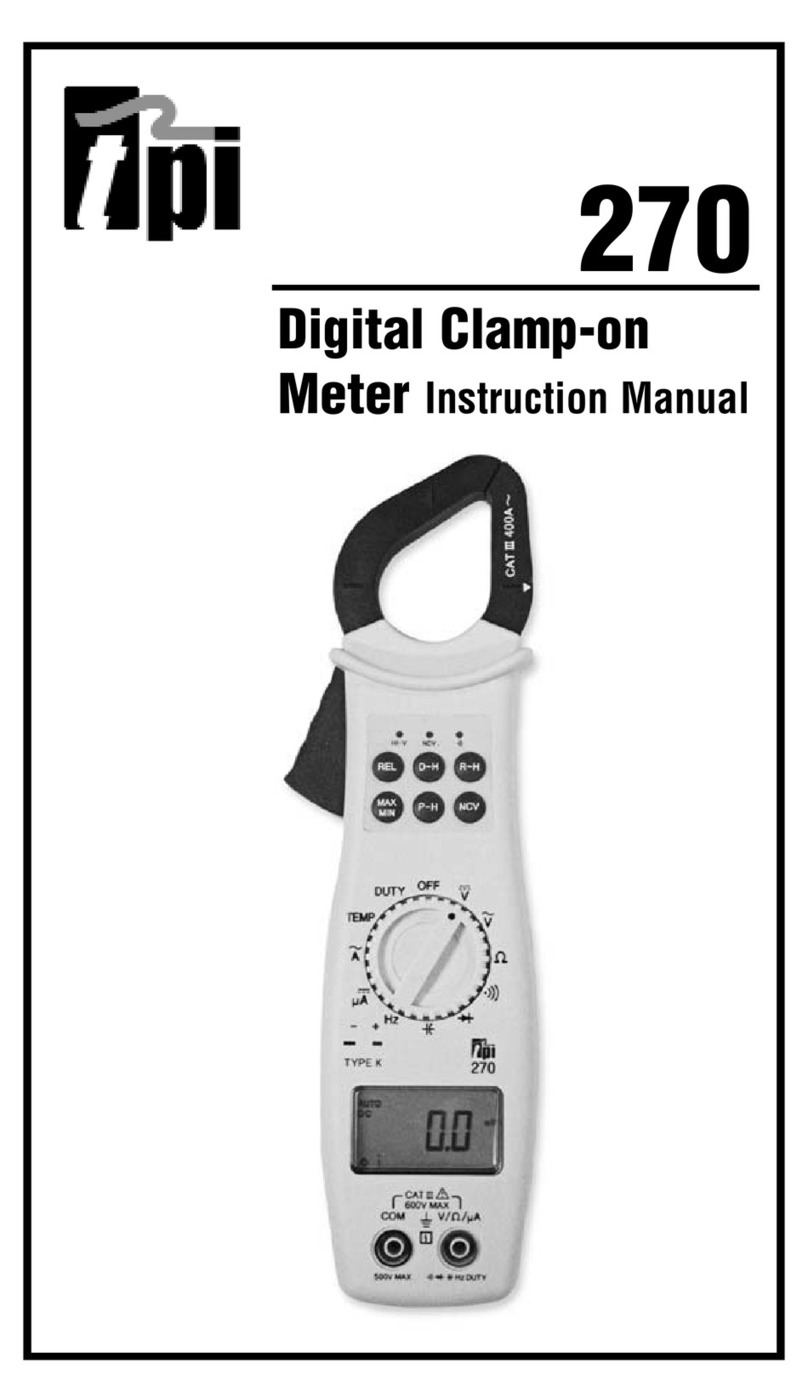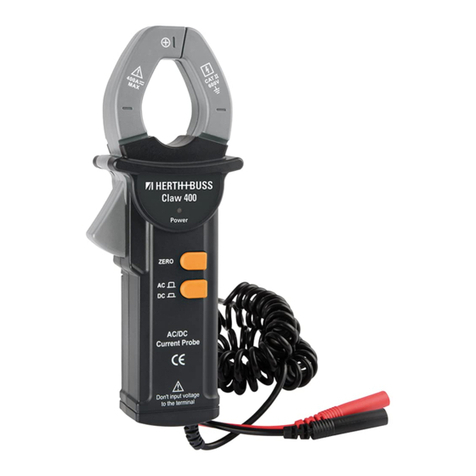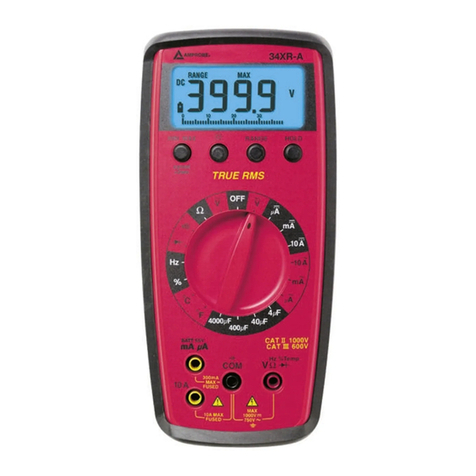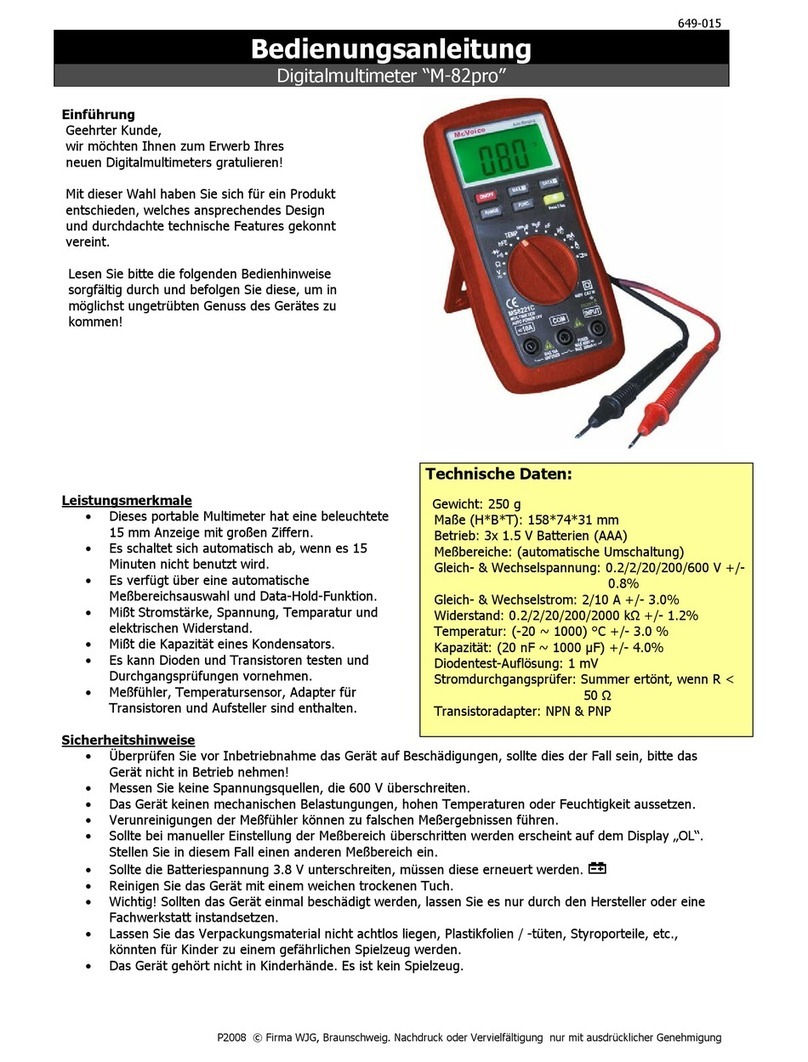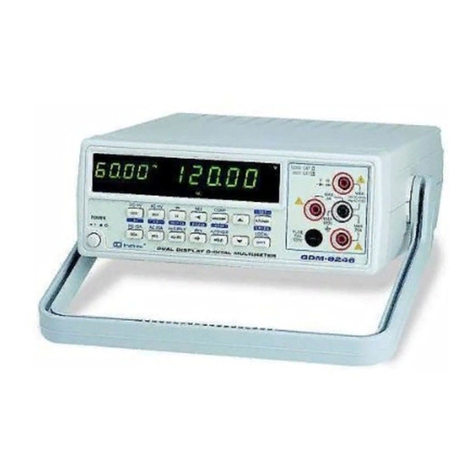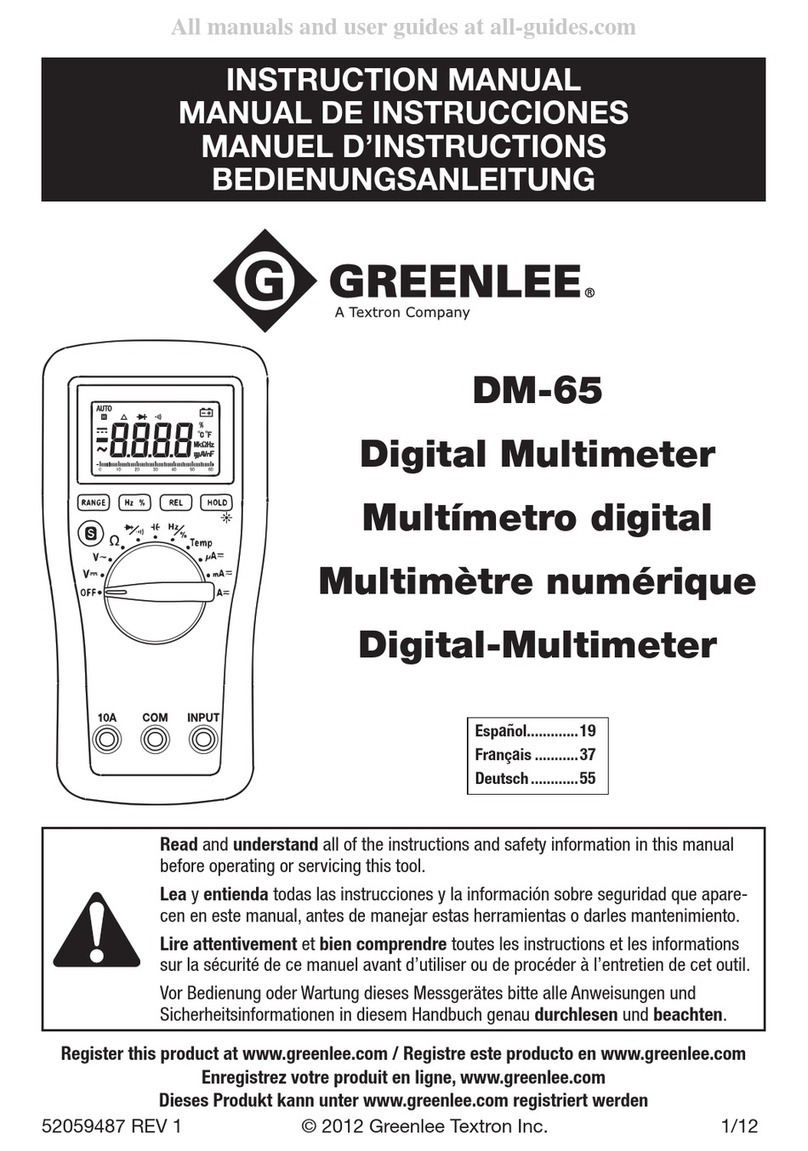Cropico DO7e User manual

Bracken Hill, South West Industrial Estate,
Peterlee, Co. Durham SR8 2SW. England.
Tel: +44 (0)191-586 3511 Fax: +44 (0)191-586 0227
www.cropico.co.uk
Digital Microhmmeter
Type DO7e
Operating Instructions


Limited Warranty & Limitation of Liability
CROPICO guarantees this product for a period of 1 year. The period of
warranty will be effective at the day of delivery.
(c) Copyright 2013
All rights reserved. Nothing from this edition may be multiplied, or made
public in any form or manner, either electronically, mechanically, by
photocopying, recording, or in any manner, without prior written consent
from CROPICO. This also applies to accompanying drawings and
diagrams.
Due to a policy of continuous development CROPICO reserves the right to
alter the equipment specification and description outlined in this
publication without prior notice and no part of this publication shall be
deemed to be part of any contract for the equipment unless specifically
referred to as an inclusion within such contract.
Digital Microhmmeter Type DO7e Operating Instructions

Disposal of Old Product
This product has been designed and manufactured with high quality
materials and components that can be recycled and reused.
When the crossed out wheelie bin symbol is attached to a product it means
the product is covered by the European Directive 2012/19/EU.
Please familiarise yourself with the appropriate local separate collection
system for electrical and electronic products.
Please dispose of this product according to local regulations. Do not
dispose of this product along with normal waste material. The correct
disposal of this product will help prevent potential negative consequences
for the environment and human health.
User Note:
These Operating Instructions are intended for the use of Competent
Personnel.
Digital Microhmmeter Type DO7e Operating Instructions

Supplied Accessories: ................................................................................................................................................. 3
1. SAFETY ...................................................................................................................................................................... 3
2. INTRODUCTION .................................................................................................................................................... 4
Display range 6000 ............................................................................................................................................... 4
3. MEASURING PRINCIPLE .................................................................................................................................. 4
4. CASE DESIGN ......................................................................................................................................................... 4
5. MAINTENANCE ...................................................................................................................................................... 4
6. BATTERY CHARGING ......................................................................................................................................... 5
BATTERIES .............................................................................................................................................................. 5
BATTERY REPLACEMENT ............................................................................................................................. 6
7. TECHNICAL DATA ................................................................................................................................................. 6
8. DESCRIPTION OF CONTROLS ...................................................................................................................... 7
Range Selection: .................................................................................................................................................... 8
Error & Status Lamps ........................................................................................................................................... 8
9. METHODS OF MEASUREMENT .................................................................................................................... 8
10. POWER UP ............................................................................................................................................................ 11
11. MEASUREMENT ................................................................................................................................................. 11
Current Mode ........................................................................................................................................................ 11
Over-Range ............................................................................................................................................................ 11
Low Battery ............................................................................................................................................................ 12
12. Connections .......................................................................................................................................................... 12
13. REMOTE .................................................................................................................................................................. 12
14. PROTECTION ....................................................................................................................................................... 12
15. CALIBRATION PROCESS ............................................................................................................................... 12
16. EQUIPMENT REQUIRED ................................................................................................................................. 13
17. PREPARATION ..................................................................................................................................................... 13
18. CALIBRATION ....................................................................................................................................................... 13
19. USING DISCRETE RESISTANCE STANDARDS ................................................................................... 14
Digital Microhmmeter Type DO7e Operating Instructions

IMPORTANT NOTE
Instruments are delivered ready for immediate use; no extras are required.
Supplied Accessories:
1 Set of test leads
1 Mains cord
1 Operating Instructions (English)
When unpacked, inspect for physical damage and report any defects immediately in writing,
retaining packaging materials for inspection. Before placing into service, ensure mains voltage
is correct, instruments are normally supplied for 230V 50Hz. Other voltages may also be
selected according to the chart in section 5, (Maintenance). Be sure to also change the fuse to
the correct type.
1. SAFETY
This apparatus is designated Safety Class I as defined in the IEC Publication 1010-1 (Amend 1)
This apparatus has been designed and tested in accordance with IEC Publication 348, entitled
“Safety Requirements for Electronic Measuring Apparatus”, and has been supplied in a safe
condition. The present instruction manual contains some information and warnings, which
must be followed by the user to ensure safe operation and to retain the apparatus in safe
condition.
This instrument has been designed and tested to BS EN:61010 overvoltage category CAT III <50V
Before switching on the apparatus, make sure that it is set to the voltage of the power supply.
The mains plug shall only be inserted in a socket outlet provided with protective earth contact.
The protective action must not be negated by the use of an extension lead without a protective
conductor.
WARNING!
Any interruption of the protective conductor inside or outside the apparatus, or disconnection of
the protective earth terminal is likely to make the apparatus dangerous. Intentional interruption
is prohibited.
When the apparatus is connected to its mains supply, terminals may be live, and the opening
of covers or removal of parts (except those to which access can be gained by hand) is likely to
expose live parts.
The apparatus must be disconnected from all voltage sources before it is opened for any
adjustment, replacement, maintenance or repair.
Any adjustment, maintenance and repair of the opened apparatus under voltage shall be
avoided as far as possible, and, if inevitable, shall be carried out only by a skilled person who
is aware of the hazard involved.
Make sure that only fuses with the required current rating and of the specified type are used for
replacement. The use of makeshift fuses, and the short-circuiting of fuse holders is prohibited.
Whenever it is likely that the protection has been impaired, the apparatus shall be made
inoperative and be secured against any unintended operation and returned to our factory or
Agent for rectification.
Prior to connecting this instrument always ensure that the circuit under test is electrically
isolated. Connecting this instrument to circuits that have not been isolated could lead to a
hazard.
Digital Microhmmeter Type DO7e Operating Instructions
3

2. INTRODUCTION
The DO7e is an accurate bench/portable Digital Ohmmeter for the measurement of resistance
in the range 1µΩto 600Ω. It offers you the four terminal resistance measurement method to
eliminate the effect of lead resistance. The measured values are displayed on a 4-digit LED
display; an overflow of the selected range is also indicated.
Display range 6000
Simple push-button or auto-range selection of the range required, ensures that the DO7e
may be easily used by unskilled personnel. Error and status warnings are illuminated when
appropriate. The utmost care has been taken to ensure that the ohmmeter will withstand an
accidental mains voltage applied to the measuring terminals, but it is not recommended that
voltage should be applied.
3. MEASURING PRINCIPLE
The measurement is true 4 terminal, using the Kelvin principle. A stable current is produced
across the resistance to be measured via the C terminals, and the voltage drop across the Rx is
measured at the P terminals. This potential drop is then compared against the voltage drop
across internal standards. The ratio of these is then converted to the resistance value of Rx and
displayed in ohms on the digital display. High accuracy and long term stability is achieved by
using Specially selected components.
4. CASE DESIGN
The case is ruggedly constructed from an ABS/polycarbonate alloy, coloured safety yellow. A
strong internal sub-frame ensures that the DO7e will withstand the harshest of environments.
The front panel is a reverse printed polycarbonate overlay with clear and unambiguous text.
5. MAINTENANCE
Normally no maintenance is required other than cleaning with a moist cloth. Avoid aggressive
detergents or solvents.
CAUTION: Before any maintenance, repair or exchange of parts or fuses, the instrument
must be disconnected from the mains supply and all power sources. In the
event of a fault occurring, the instrument should be returned to our factory or
Agent. A mains fuse is fitted to the mains inlet socket on the front panel, and
should be replaced if necessary.
CAUTION: Disconnect mains lead and all connecting leads, before removing fuse holder.
Replace only with the correct fuse type, ie. according to the following chart.
The input circuits are protected by a 6 AMP fuse located in a holder on the main printed circuit
board. Access is gained by removing the top cover. Only replace with the correct fuse type as
below.
10A Am 550V rms HRC Ceramic Cartridge 10 x 38 mm
IEC 269-2-1 NFC63-210
Digital Microhmmeter Type DO7e Operating Instructions
4
Line
Voltage
Selection
120V
230V
Maximum Input Power : 18VA
Range
VAC
47-63Hz
104-132V
209-264V
Fuse (250V)
IEC 127
5 x 20 mm
250mA(T)
125mA(T)

6. BATTERY CHARGING
The DO7e has a built-in rechargeable sealed lead acid battery, which is fully charged when
delivered. To ensure good service life from the battery, the DO7e incorporates a sophisticated
battery management system. Low battery condition is indicated by a panel mounted LED.
The battery charger is built in and the instrument may be connected to 110/ 230 volts supply.
The appropriate voltage setting must be selected on the inlet socket and the correct fuse
inserted. The LINE LED will illuminate on the front panel to indicate when the mains supply is
connected.
Charging is automatically controlled with built-in protection circuits eliminating the possibility of
over-charging. The display will blank when the battery voltage is too low to sustain
measurements, and the low battery indicator will illuminate. The battery will recharge in
approximately six hours, and the DO7e lid should be open to allow for maximum ventilation.
IMPORTANT: Always connect instrument to mains supply after use and top up battery.
Instruments should be stored with batteries fully charged, and when stored for long
periods the batteries should be recharged each month.
Should the batteries become deeply discharged due to being left for long periods without
charge, then the internal charger will automatically sense the battery state and will trickle
charge with a very low current to restore the batteries before automatically switching to
fast charge. This low current charge may take up to 20 hours to restore the batteries.
Continuous charging will not damage the batteries and will, in fact, keep them in best
condition.
BATTERY
The internal battery is a sealed lead acid type. Care should be taken when disposing, and it
may be returned to Cropico for safe disposal.
Any regulations and directions applying to the disposal of such material must be applied.
Do not dispose of battery in fire.
Do not short circuit.
Do not crush, puncture, open, dismantle or otherwise mechanically interfere with the battery.
NOTE: If storing for long periods, the batteries should be fully recharged every six months.
Digital Microhmmeter Type DO7e Operating Instructions
5

BATTERY REPLACEMENT
Competent and skilled personnel should only carry out Battery replacement. Care should be
taken to ensure the correct polarity of the connecting wire. The Red Wire always to the positive
battery terminal (Note the blue tag fitted to this wire does NOT indicate polarity). If in doubt
please refer to our Service Department.
7. TECHNICAL DATA
Digital Display : 4 digit, LCD 0.8” height;
6000 count with automatic
decimal point and error
warning lamps
Working temperature : 0...+40°C rel.
humidity max. 80%
Normal temperature : 20°C
Storage temperature : -20°C ... +50°C
Mains connection : 115V
Range 103V-127V 47-63 Hz (400Hz optional)
230V
Range 207V-253V 47-63Hz (400Hz optional)
Power consumption < 20VA
Size (mm.) : 343 x 327 x 152
Mass : 6.0 Kgs.
Measurement
Resistance : True four-terminal measurement
with fixed dc measuring currents.
Measuring time : Approx. 0.5 seconds
Polarity : Forward and reverse measurement
current may be selected, plus
average mode which automatically
displays the average value of
positive and negative polarity
measurement.
Ranges and Accuracy
* NOTE Temperature coefficient to be added to uncertainty when operating outside the range 15 to 25°C
NOTE: Measurements on the lowest range 60µΩmay have an additional zero offset of up to 20
digits, if the measuring current is applied repeatedly for long periods. This offset can be
eliminated by using the average measuring mode.
Digital Microhmmeter Type DO7e Operating Instructions
6
Range Resolution Typical
Current
Uncertainty
At 20°C ± 5°C, 1 Year
Temperature
Co-efficient/°C*
600 Ω
60 Ω
6 Ω
600 mΩ
60 mΩ
6 mΩ
100 mΩ
10 mΩ
1 mΩ
100 µΩ
10 µΩ
1 µΩ
1 mA
10mA
100 mA
1 Amp
1 Amp
10 Amp
±(0.25% Rdg + 0.05% FS)
±(0.25% Rdg + 0.05% FS)
±(0.25% Rdg + 0.05% FS)
±(0.25% Rdg + 0.05% FS)
±(0.25% Rdg + 0.05% FS)
±(0.25% Rdg + 0.05% FS)
40 ppm Rdg + 30 ppm FS
40 ppm Rdg + 30 ppm FS
40 ppm Rdg + 30 ppm FS
40 ppm Rdg + 30 ppm FS
40 ppm Rdg + 30 ppm FS
40 ppm Rdg + 250 ppm FS

4 Digit LCD Display
Measuring Terminals
Mains Socket
Auto Range Key
On Key
OFF Key
CAL Key
Current Mode Keys
Measure Key
Remote Start
Socket
8. DESCRIPTION OF CONTROLS
Digital Microhmmeter Type DO7e Operating Instructions
7
Measuring Terminals
4 Digit LCD Display
Remote Start
Socket
Measure Key
Current Mode Keys
CAL Key
OFF Key
On Key
Auto Range Key
Mains Socket

Measurement Polarity
The measuring current polarity may be selected from the front panel. The display will indicate
either + or - to denote the current flow. This is particularly useful when evaluating circuits with
thermal emf or where diode effects can influence the measurement. For measurements where
thermal emf can cause a large measuring zero error, we have provided an additional automatic
average button. When pressed, the measuring current will automatically be reversed and the
average value displayed, thus eliminating the need for external computations. This average
facility will also adjust the measurement time automatically, thus giving the fastest possible
measurement even on inductive circuits.
The +ve and -ve lamps will light to indicate that the current polarity is changing. For very
unstable values where the average mode is unable to establish a stable reading, the averaging
will be aborted after approximately 25 seconds and the display will indicate - - - - A new
average cycle will be automatically initialised.
Range Selection:
The 6 ranges may be selected manually by simply pressing the desired range button. The
selected range will be indicated by an LED and over-range will be indicated by the display
reading - - - -. An Auto range facility is also provided, pressing the AUTO key sets the DO7e in
to auto range mode.
Error & Status Lamps
These LEDs will light to indicate the instrument status.
LINE : Mains supply is connected to the instrument.
LOBAT : Indicates low remaining battery capacity
CHG : Indicates that the internal battery is charging
O/C One of the measuring leads is open circuit
LEAD : (too high resistance), or not connected to
test sample correctly, or the internal protection
fuse is open circuit. The lamp will always
light in standby mode.
9. METHODS OF MEASUREMENT
9.1 Ohmmeter Connections
The Digital Ohmmeter type DO7e employs a four wire method of measurement, ie. it is
necessary to make four connections to the resistor under test. The instrument is supplied with
four leads; two for the potential connections which are made across the test resistor at the
points between which the resistance is to be determined; and two for the current connections
which connects the test resistor to the supply circuit.
a) Connect the black leads to the +I and +U terminals, and the red leads to terminals
-I and -U.
b) Clip on to the resistor under test (fig. 9-1). Cleanliness is important and if the sample
is not clean, a rub with an abrasive paper to remove oxides is recommended.
Digital Microhmmeter Type DO7e Operating Instructions
8

Fig. 9.1 Combined current and potential probes (Kelvin clips)
c) It is not always possible to use the combined current and potential clips, in which
case test leads with spade tags or special test fixtures may have to be made for the
user to suit particular applications.
d) Fig. 9-2 illustrates connections to various types of test resistors.
e) When measuring 4-terminal resistance standards, do not use the combined current
and potential probes. Make four separate connections to the current and potential
terminals.
Digital Microhmmeter Type DO7e Operating Instructions
9

Connections to Cable Joint
C1
(
+I
)
P1
(
+U
)
C2
(
-I
)
P2
(
-U
)
Connections to Stud Terminals
C1
(
+I
)
C2
(
-I
)
P1
(
+U
)
P2
(
-U
)
Connections to Current Shunt
C1
(
+I
)
C2
(
-I
)
P1
(
+U
)
P2
(
-U
)
Fig. 9.2 Various types of resistors
Digital Microhmmeter Type DO7e Operating Instructions
10
C1 (+I)
C2 (-I)
P2 (-U)P1 (+U)
Connections to Stud Terminals
C1 (+I) P1 (+U) P2 (-U) C2 (-I)
Connections to Cable Joint
Connections to Current Shunt
C1 (+I)
P1 (+U)
C2 (-I)
P2 (-U)

10. POWER UP
When the DO7e is first switched on, an internal self-test is automatically performed. The display
indicates -8888 followed by PASS and then switches to standby mode ready for measurement.
Should the internal checks indicate an error, then the display will read “HELP”. Contact our
Service Department or your local agent for assistance.
The DO7e will perform an automatic zero sequence and finally sets to the following default
start-up mode ready for use. The selected measuring range will be 600Ω, and the DO7e will
then be in stand-by mode. The display will blank after approx. 25 seconds.
11. MEASUREMENT
Connect the resistance to be measured (Rx) to the measuring terminals in accordance with the
diagram on the instrument panel. Select the range required or Auto range, and the current
measurement mode, ie. +, -or average. The LED lamps will light to indicate which buttons are
active. To initialise the measurement, press the MEAS button, a single measurement will be
initialised and the value held on the display for approximately 25 seconds. After 25 seconds
have elapsed the display will blank with only the range LED alight, the last measured value
may be recalled to the display by pressing the MEAS key. To make another measurement the
MEAS key should be pressed again Should you wish to initialise a continuous reading, then
press and hold the MEAS key until a long bleep is heard this will lock the measurement in
continuous mode. Note continuous measurement is not possible on the lowest 6mΩrange. The
measurement will continue until the MEAS key is pressed again. The DO7e will automatically
power off after 5 minutes with no key activity to preserve battery life. Note: the MEAS key LED
will be lit whilst a measurement is in progress.
Current Mode
The current mode can be set to measure with +I, -I or AVE. The AVE mode should be selected
for all measurements that are not inductive, as this eliminates errors due to thermal emf in the
measurement circuit or test leads. In the AVE mode the DO7e measures with the current in both
directions and displays the average of the two readings. For measurement of inductive circuits
the measuring current should either be set in + or - mode.
Over-Range
The display will indicate - - - -.
Select a higher range.
Open Circuit Lead
O/C LEAD LED will light and the display will indicate - - - - if the instrument detects that the lead
resistance is too high. ( The C terminals are checked for compliance voltage). Measurement
cannot be made if this warning message is displayed. This warning will also be displayed if the
internal protection fuse is open-circuit.
When in STANDBY mode this LED will always be lit.
Digital Microhmmeter Type DO7e Operating Instructions
11

Low Battery
The LOBAT LED will light when the battery has approx. 10% charge left, when this LED lights
the DO7e should be connected to a mains supply and the batteries automatically recharged.
Full measurement accuracy is maintained even when the LOBAT LED is lit.
12. Connections
When making good quality measurements, it is important to ensure that all measuring leads are
in good condition, and less than 0.2 ohms resistance.
It should also be noted that some spade tags and crocodile clips can produce high thermal
emfs when warmed, particularly nickel-plated brass types. This can cause problems when,
for example, connecting too hot motor windings. The solution is to use plain copper or brass
connections keeping them clean and oxide-free.
Measuring Terminals
The heavy duty measuring terminals are designed to accept 4mm banana plugs in the
top socket, Bare wires and spade tags may also be clamped in the side entry socket.
13. REMOTE
If a footswitch, test leads with start button or other similar external switch is plugged into the
REMOTE socket, it will behave as the MEAS key.
14. PROTECTION
Every effort has been made to protect the instrument against voltages being applied to the
terminals. A large 6 Amp fuse is fitted internally to the C measuring line and a gas discharge
tube, GDT, is across the C terminals. If voltages above approximately 90V are applied to the
measuring terminals, the GDT will strike, effectively shorting the C terminals through the 6 Amp
protective fuse, which will interrupt the circuit.
The fuse fitted will interrupt up to 40,000 Amps. The P terminals are not fused and will withstand
up to 460 Volts without damage to the instrument.
WARNING!
To replace the protection fuse, the top instrument panel should be removed, but only after the
mains supply and all input connections are removed. The protection fuse is located on the main
printed circuit board. Only replace with the correct fuse rating.
15. CALIBRATION PROCESS
This procedure describes the standard calibration method for the DO7e Ohmmeter using
Cropico Calibration Standard Type MTS2. If discrete resistance standards are to be used
instead, refer to section 21 before proceeding.
CAUTION
The DO7e will be factory-calibrated to its full accuracy when delivered and any recalibration
by the user will invalidate this initial calibration. The user should therefore be certain that only
authorised and competent personnel are permitted access to the calibration facility, which is
code protected.
Digital Microhmmeter Type DO7e Operating Instructions
12

16. EQUIPMENT REQUIRED
Cropico Calibration Standard Type MTS2
Set of 2 low thermal emf leads
Set of 2 general purpose leads (10A rating)
17. PREPARATION
17.1 Ensure all retaining screws are fitted.
Place unit in temperature controlled environment for a minimum of 4 hours. Ensure
batteries are fully charged.
17.2 Connect each of the four DO7e terminals to the equivalent terminals on the calibration
Standard. It is essential that low thermal emf leads are used for the P1 and P2 leads (see
Fig.17.1 for the preferred setup).
P1, P2 LEADS - PURE COPPER, MULTI STRANDED
C1, C2 LEADS - 10A RATING (55/0.15MM)
17.3 An internal battery powers the DO7e and this should be fully charged before carrying out
the calibration. The mains charger can be left connected, if desired.
17.4 Set the calibration standard to 400 Ohm, Zero.
17.5 Turn the DO7e power ON whilst holding down the CAL key.
17.6 Leave for a few minutes to stabilise.
18. CALIBRATION
ENTERING A PASSCODE & CALIBRATION
1. Hold down CAL key, whilst powering up - the DO7E displays ‘CODE’.
2. Enter the 4-digit passcode (default is 9252) and press OK.
3.
If the code was incorrect, a long beep is emitted, and the user should start again from #2.
4. If correct, the DO7e displays zero (eg ‘0.0’), and is now in Calibration mode.
5.
At this point, a specific range can be chosen for calibration by pressing the relevant
range key. Otherwise, each range will be selected in turn automatically, starting with 600W.
6. With the display showing zero, select the correct resistor value and the ZERO setting
on the calibration box, and press OK. If there is an error, a long beep will be emitted,
and the user should check the settings, and repeat #6.
7. If the zero measurement is successful, a short beep is emitted, and the full-scale value
is displayed (eg 600.0).
Digital Microhmmeter Type DO7e Operating Instructions
13
+I
+U
-U
-I
CALIBRATION STANDARD MTS2
+I
+U
-U
-I

8. Select FULL SCALE on the calibration box.
9. Then enter the exact value of the standard resistor, using all four digits (eg 300.0) - the
decimal point will be added automatically - and press OK.
10. If the entered value is outside the allowed limits, a long beep will be emitted immediately,
and the user should go back to #9.
11. If the entered value is OK but there is an error in the measurement, a long beep will be
emitted at the end of the measurement. The user should check the settings, and go
back to #8.
12. If the full-scale measurement is successful, a short beep will be emitted, and the user
is returned to #4 with the next range down already selected.
Note:
Calibration mode can be exited by pressing the CAL key at any time, except when a number is
being entered.
Partially-entered codes or values can be cleared at any time by pressing CLE, and then
reentered.
Ideally, the DO7e 600W range should be calibrated against a 600Ωstandard, but the software
will allow any value between 90Ωand 606Ω. Similar ratios apply to the other ranges.
CHANGING A PASSCODE
1. Carry out #1 to #4 as above, using the existing passcode.
2. Press and hold the CLE key for 2 seconds - the DO7e displays ‘CODE’.
3. Enter the new 4-digit passcode and press OK - the DO7e displays ‘CODE’ again.
4. Re-enter the new 4-digit passcode and press OK.
5. If the new passcode was not entered correctly both times, a long beep will be emitted,
and the process must be repeated from #3.
6. If correct, the DO7e displays zero (eg ‘0.0’), and is now in Calibration mode. If this is not
required, it can be exited by pressing CAL.
* * END OF NORMAL CALIBRATION PROCEDURE * *
19. USING DISCRETE RESISTANCE STANDARDS
20.1 Discrete, 4-terminal resistance standards may be used in place of the Cropico Calibration
Standard. The standards must have an uncertainty better than 0.01% if the full calibration
accuracy is to be achieved. Full consideration of the DO7e measuring current must also
be taken into account when selecting the standards. The DO7e can be calibrated to
standards between 1000 and 6000 digits for each range using the KYB entry. However,
full accuracy will only be achieved if standards of 4000 to 6000 digits are used. The
following nominal standards are recommended:
400, 40, 4, 400m, 40m and 4m Ohm
Digital Microhmmeter Type DO7e Operating Instructions
14

20.2 In all measurements the P1 and P2 terminals are conventionally connected. Bear in
mind that thermal emfs may be present. The DO7e is particularly sensitive to these
on the 6m Ohm range.
20.3 For FS measurements, connect the C1 and C2 leads in the conventional manner (see
Fig 20.1).
20.4 For ZERO measurements, connect the C1 and C2 leads to the C2 terminal of the
standard (see Fig 20.2).
FULL SCALE CALIBRATION
P1, P2 LEADS - PURE COPPER, MULTI STRANDED
C1, C2 LEADS - 10A RATING (55/0.15MM)
Fig. 20.1
ZERO CALIBRATION
P1, P2 LEADS - PURE COPPER, MULTI STRANDED
C1, C2 LEADS - 10A RATING (55/0.15MM)
Fig. 20.2
* * END OF TEST PROCEDURE * *
Digital Microhmmeter Type DO7e Operating Instructions
15
C1
P1
P2
C2
C1
P1
P2
C2
DO7 STANDARD RESISTOR
C1
P1
P2
C2
C1
P1
P2
C2
C1
P1
P2
C2
C1
P1
P2
C2
DO7 STANDARD RESISTOR

Remote Start Socket
Connect remote switch to pins 1 and 2 when switch closed it acts as MEAS key
Digital Microhmmeter Type DO7e Operating Instructions
16
Description
Calibration Standard
Ordering Code
MTS2
Description
Pt100 Temperature Sensor Probe length 200mm, diameter 6mm.
Fitted with 1 Metre Lead and DIN Plug
Ordering Code
5000-Pt100
Description
1 metre wire clamp with hardwood base suitable for cable
diameters up to 100mm
1 metre wire clamp with metal base and provision for temperature
sensor suitable for wire cross section 1 to 1000mm
1 metre wire clamp with water bath for the precise measurement
of 1 meter cable samples 1 to 1000mm
Ordering Code
C02
C02-A
CO3
TEMPERATURE PROBE
WIRE CLAMPS
For the precise measurement of 1 meter cable samples we offer 3 wire clamp options.
Description
Duplex Handspikes with 2.5 metre lead length, current and
potential spikes suitable for plate or Bussbar measurements.
Duplex Handspikes as a HS01-P but with 2.5 and 15 metre lead lengths
Large Kelvin clips with 3 metre lead length suitable for attaching
to rods bars or cables up to 38mm diameter
As LS03-P but with lead lengths 3 and 15 metres
Executive lead set consisting of 4 x 1 metre leads with banana
plugs, 4 x crocodile clips 4 x test prods and 4 x Kelvin clips (KC1)
jaw opening 4mm
Kelvin lead set comprising of miniature Kelvin clips (KC2) with 1
meter leads attached terminated with banana plugs Jaw opening
6mm. Suitable for fine wires.
Ordering Code
HS01-P
HS02-P
HS03-P
HS04-P
LS05
LS06-P
20. AVAILABLE ACCESSORIES
MEASURING LEADS
The DO7e may be used with a variety of lead sets. The following are the available selection.
Remember, if you do not see suitable leads for your application, please consult our
customer help desk.
Viewed from panel

CE Declaration of Conformity
Manufactured by:
Seaward Electronic Ltd, Bracken Hill, South West Industrial Estate
Peterlee, County Durham, SR8 2SW, England
Statement of Conformity
As the manufacturer of the apparatus listed, declare under our sole
responsibility that the product:
Cropico DO7e Ohmmeter
To which the declaration relates are in conformity with the relevant clauses
of the following standard(s):
BS EN61010-1:2010
Safety requirements for electrical equipment for measurement, control, and
laboratory use - Part 1: General requirements.
BS EN61010-2-030:2010
Safety requirements for electrical equipment for measurement, control, and
aboratory use - Part 2-030: Particular requirements for testing and
measuring circuits.
BS EN61326-1:2006
Electrical equipment for measurement, control and laboratory use - EMC
requirements - Part 1: General requirements.
Performance: The instrument operates within specification when used
under the conditions in the above EMC and Safety Standards.
The product identified above conforms to the requirements of Council
Directive 2004/108/EC and 2006/95/EC.
This Conformity is indicated by the symbol , i.e. “Conformité Européenne”
Seaward Electronic Ltd. is registered under BS EN ISO9001:2000
Certificate No.: Q05356.
Digital Microhmmeter Type DO7e Operating Instructions
Table of contents


